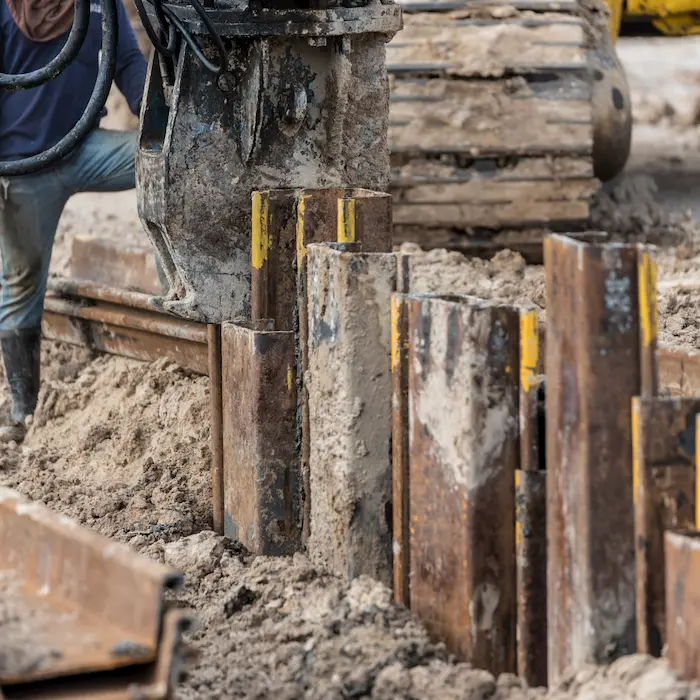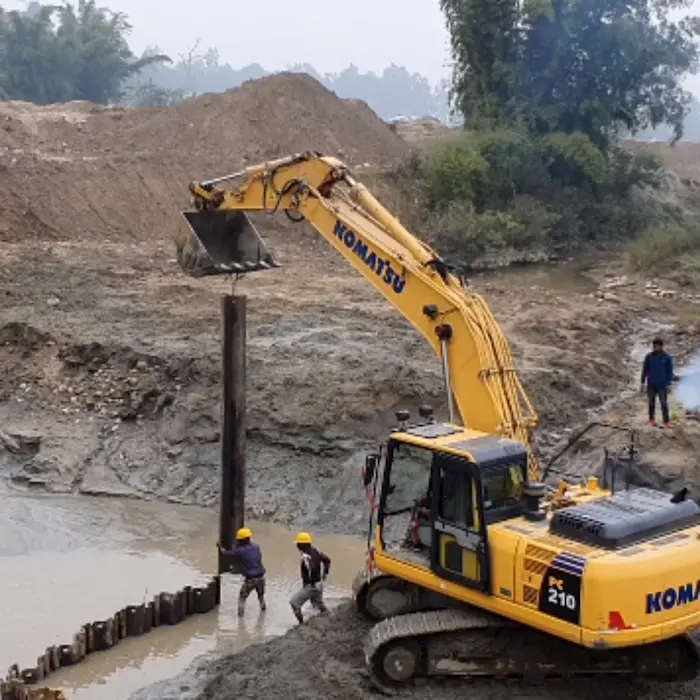Sheet piles are used in a wide range of construction projects for a variety of reasons. In all, they are durable and sturdy materials that are used for retaining walls, marine projects, basement construction, and other constructions that need to be driven into the ground. This type of rigid material is lightweight but can also withstand the driving process of the machinery that will be used in order to use it.
When it comes to sheet pile installation methods it varies based on soil conditions, sheet pile length, the machine used for installing the sheet piles, and many other important factors that need to be considered. In today’s post, we’re going to discuss how to install sheet piles and overall Sheet Pile Installation Methods. As a result, stay with me and take a closer look at all of the sections.
How To Install Sheet Pile?

As far as steel sheet pile installation into the ground is concerned, there is a wide variety of Sheet Pile Installation Methods. The main parameters that have to be taken into account when determining the integrity of the soil, the section and length of the sheet piles, the driving equipment, the wall type (permanent or temporary), the visible wall (coatings for aesthetics), the installation tolerance (vertical, position,…) and the type of interlocking system used.
The most common installation techniques use vibratory hammers, impact hammers or presses, or a combination of these driving equipment. In compact soil layers, for example, it might be better to use a vibratory hammer or a pressing machine to start driving long sheet piles and then finish driving the last meters with an impact hammer in order to achieve a much faster and more effective drive.
The standard Sheet Pile Installation Methods include the following:
- Panel driving,
- Panel driving with staggered driving.
- Pitch and drive.
In some soils, it may be recommended to prevent the interlocks from clogging in order to prevent the soil from sinking. It can be done by applying a foam or bituminous product inside the interlocks (sealing system) or by welding a plate/screw at the bottom of the interlock in order to achieve this.
Sheet Pile Installation Methods

In the previous section, you learned that sheet piles are typically installed by using one of three key Sheet Pile Installation Methods:
- Panel driving
- Panel driving with the staggering of sheet piles
- Pitch and drive
Sheet pile installation methods statement depends on the prevailing conditions at the site where construction is happening and should be based on a thorough soil investigation. To install sheet piles, conventional pile foundation methods typically use vibratory hammers, impact hammers, presses, or a combination of them.
Panel Driving
Using this sheet piling installation methods, sheet pile panels are threaded together before piling occurs, using a stiff guide frame or ‘template’, into which sheet piles are placed. As a result, the sheet pile wall can remain vertical even in very soft soils, where learning can be an issue.
As an additional benefit, it can be used to assist in the installation of longer piles in locations with difficult soil conditions, as well.
Because of the threading and handling involved, it is a more time-consuming sheet piling method than others, although it is often used for underground parking garages and basements.
Panel Driving With The Staggering Of Sheet Piles
It is similar to panel driving in that alternate piles are reinforced with a tip and the piling is staggered so that the reinforced sheet piles can be driven deeper than unreinforced sheet piles due to the staggered piling positioning. When soil conditions are compacted, this Sheet Pile Installation Methods of driving sheet piles can be very useful for driving sheet piles.
Pitch And Drive
In terms of piling construction methods, this is one of the most popular methods as it is relatively quick and low cost. It is common to install sheet piles in locations where learning will not be a concern, where the soils are not too compact, and, in many cases, where the sheet pile installation is temporary, in which case the individual piles are threaded into their final depths.
Pitch and drive piles are typically short in length since they are installed by means of pitching and driving them. For this type of one sheet pile construction method, hydraulic presses are the only ones that can be used.
With a Giken silent pressing rig, the pitch and drive method of installing sheet piles can be achieved without the noise issues that can be associated with this style of installation.
Use of Driving Assistance Methods
When it comes to the installation of sheet piles, environmental factors can sometimes make the process difficult. If this is the case, then driving assistance methods can be used to make the process of installing sheet pipes more efficient. There are two methods in use for this purpose: jetting and drilling.
A jetting technique involves using the force of water in order to soften soil that has been compacted very tightly. During the driving process, the jetting equipment is attached to the sheet pie to ease the process of driving. In this way, lightweight driving equipment can use the sheet piles to drive them on the ground without encountering any resistance from the ground. As a result, the force of the jet is customized based on the condition of the soil.
Drilling is used to softening the soil’s resistance to the sheet piles by reducing its resistance to the drilling. The sheet piles are installed on the ground before the sheet piles are installed on top of them. It is useful to have this type of driving assistance when the ground is hard and compact. This process can be used to reduce damage to the sheet piles because it only requires that the sheet piles be inserted into the hole that has already been drilled. Additionally, the holes can also serve as a guide that prevents the piles from leaning to one side or the other.
Interested in learning more? Check out this video:
Additional Tips For Installing Sheet Pile
- Make sure you always have a template system on site.
- A good rule of thumb is to use the crane boom length twice the length of the steel sheet piling you are driving when driving long, heavy sections of steel sheet piling.
- In order to avoid annoying soil plugs in the future, you must drive the sheets with the “male” interlock leading.
- In the case that the female interlock is required to lead, use a bolt or other object to prevent debris from filling the female end of the interlock.
- It is important to thread and set the panel of sheet piling before driving any sheets to grade.
- Ensure that the first two sheets are aligned and plumb and drive them carefully and accurately.
- As much as possible, drive the sheets in pairs by using the hammer in the center of each pair of sheets.
- A number of contractors recommend not driving a sheet more than 1/3 of its length before driving the pile adjacent to it.
- As a general rule, letting the sheets fall “free-fall” and drop in order to aid in penetration will generally result in the sheets falling out of plumb in the process.
- To unthread the sheet piling, allow it to “slide” until it stops by its own weight, and then thread it again. It is possible to assist penetration at this point by using a hairpin.
- To ensure the wall is plumb, sheet piling should be checked periodically (at least every fifth single sheet or every third double sheet).
- Make sure you do not rush the pile foreman.
Final Verdict
Having understood sheet pile installation methods, you have reached the end of this article. As a result, you can get an idea of what type of sheet piles you need to use in your construction project and how you can combine different methods for better results on your construction project. Among many other factors, driving methods can differ depending on many factors, such as the type of soil, the length of the sheet pile, the type of machine used for the installation, and so on.
The use of sheet piling can be found in a wide range of construction projects. They are interconnected to form a sheet that is placed on the ground by interlocking the piles together. The purpose of these sheets is to add support to a structure in order to make it more stable. It is common to use sheet piles on both land-based and maritime projects. A few examples include underground parking garages, seawalls, and dams, to name just a few.
Frequently Asked Questions
How long does it take to install a sheet pile?
Depending on the bottom conditions and obstructions, it would take two to three days to complete the cycle of excavation, old pile removal, and pile installation for the 40 feet. It is likely the old pile would have to be removed and new piles would have to be installed in a timely manner.
What are the different types of sheet piling?
Sheet piles come in four basic types, all of which have their own specific functions.
- Steel sheet piles.
- Vinyl sheet pile.
- Wooden sheet pile.
- Concrete sheet piles.
Which sheet piles are most commonly used?
There is no doubt that steel sheet piles are the most popular piles due to the fact that they have high strength, are easy to handle, and are easy to construct. There are many different kinds of cross-sections and shapes that you can choose from when choosing steel sheet piles.
Are sheet piles load-bearing?
This type of pile is made of thin plates and is usually made of concrete, timber, or steel. It is used to separate members or to prevent the seepage of water into the ground. This type of load cannot be carried vertically as it is not designed to do so. Therefore, it is also known as a non-load-bearing pile as sheet piles are not designed to bear loads.
